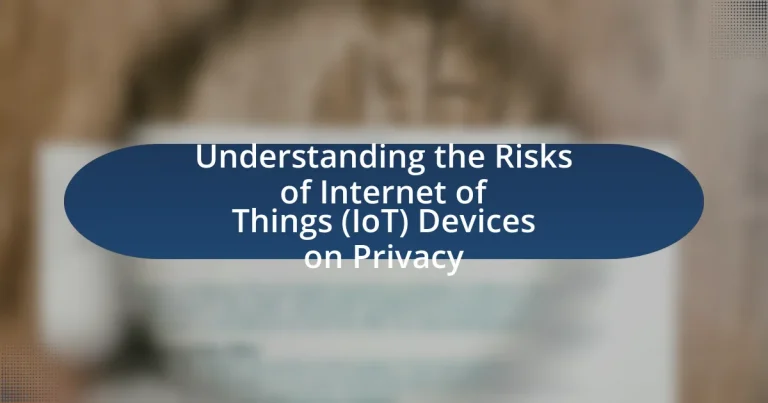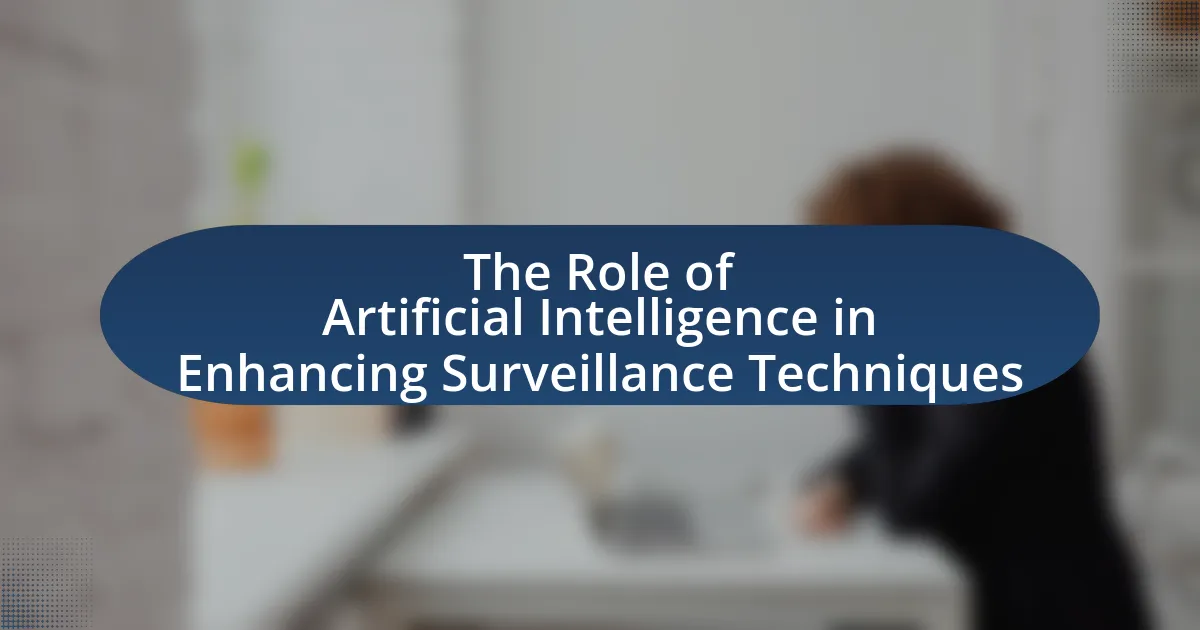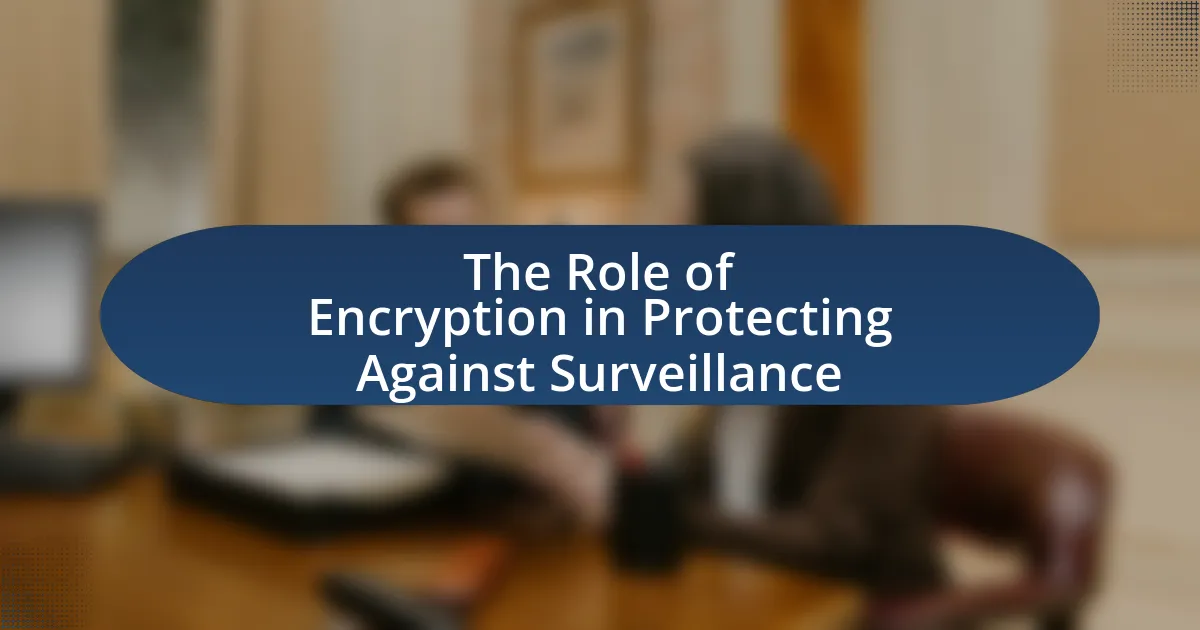The article focuses on the privacy risks associated with Internet of Things (IoT) devices, highlighting issues such as unauthorized data access, data breaches, and surveillance. It details how IoT devices collect sensitive personal information through various methods, including sensors and connectivity features, and discusses the types of data commonly gathered. The article also examines vulnerabilities in IoT devices, the importance of security measures like software updates, and the role of user awareness in mitigating risks. Additionally, it addresses the broader societal implications of IoT privacy risks, including potential legal consequences for companies and strategies for enhancing privacy protections.
-Devices-on-Privacy-1.webp)
What are the Risks of Internet of Things (IoT) Devices on Privacy?
The risks of Internet of Things (IoT) devices on privacy include unauthorized data access, data breaches, and surveillance. IoT devices often collect sensitive personal information, which can be exploited if security measures are inadequate. For instance, a 2020 report by the Identity Theft Resource Center indicated that 1,108 data breaches exposed over 300 million records, many involving IoT devices. Additionally, the interconnected nature of these devices can lead to vulnerabilities where a breach in one device compromises the entire network, further endangering user privacy.
How do IoT devices collect personal data?
IoT devices collect personal data through various methods, including sensors, cameras, and connectivity features. These devices gather information by monitoring user behavior, environmental conditions, and interactions with other devices. For instance, smart home devices like thermostats and security cameras track user habits and preferences, while wearable fitness trackers collect health-related data. According to a report by the International Data Corporation, the number of connected IoT devices is expected to reach 41.6 billion by 2025, highlighting the extensive data collection capabilities of these technologies.
What types of data are commonly collected by IoT devices?
IoT devices commonly collect various types of data, including environmental data, user behavior data, location data, and device status data. Environmental data encompasses temperature, humidity, and air quality, which are essential for smart home systems and industrial applications. User behavior data tracks interactions with devices, providing insights into usage patterns and preferences. Location data, often gathered through GPS, helps in navigation and location-based services. Device status data includes operational metrics such as battery life and connectivity status, which are crucial for maintenance and performance monitoring. These data types are integral to the functionality of IoT devices and raise significant privacy concerns due to their potential for misuse.
How is this data transmitted and stored?
Data from Internet of Things (IoT) devices is transmitted primarily through wireless communication protocols such as Wi-Fi, Bluetooth, and cellular networks. These protocols enable devices to send data to cloud servers or local storage systems for processing and analysis. For instance, a smart thermostat collects temperature data and transmits it via Wi-Fi to a cloud server, where it is stored and can be accessed remotely by users. This method of transmission is often secured using encryption standards like TLS (Transport Layer Security) to protect data during transit. Additionally, data storage typically occurs in centralized cloud environments or decentralized edge devices, depending on the architecture of the IoT system. Cloud storage allows for scalability and remote access, while edge storage can reduce latency and bandwidth usage by processing data closer to the source.
What vulnerabilities exist in IoT devices?
IoT devices are vulnerable to several security risks, including weak authentication, inadequate encryption, and insecure software updates. Weak authentication allows unauthorized access, as many devices use default or easily guessable passwords. Inadequate encryption can lead to data interception during transmission, exposing sensitive information. Additionally, insecure software updates may enable attackers to exploit vulnerabilities if devices do not verify the integrity of the updates. According to a 2021 report by the Internet of Things Security Foundation, 98% of IoT devices are susceptible to at least one of these vulnerabilities, highlighting the critical need for improved security measures in IoT ecosystems.
How can weak security measures compromise user privacy?
Weak security measures can compromise user privacy by allowing unauthorized access to personal data. For instance, inadequate encryption protocols can enable hackers to intercept sensitive information transmitted between IoT devices and their servers. A study by the Ponemon Institute in 2020 found that 63% of organizations experienced a data breach due to weak security practices, highlighting the direct correlation between insufficient security and privacy violations. Additionally, poorly configured devices can be exploited to gather user information without consent, further eroding privacy.
What role do software updates play in maintaining security?
Software updates play a critical role in maintaining security by patching vulnerabilities that could be exploited by attackers. These updates often include fixes for known security flaws, which, if left unaddressed, can lead to unauthorized access, data breaches, or other malicious activities. For instance, a report by the Cybersecurity and Infrastructure Security Agency (CISA) highlighted that 85% of successful cyberattacks exploit known vulnerabilities for which patches are available. Regularly applying software updates ensures that devices, especially IoT devices, are protected against emerging threats and maintain their integrity and confidentiality.
Why is user awareness important in mitigating risks?
User awareness is crucial in mitigating risks associated with Internet of Things (IoT) devices because informed users can recognize potential threats and adopt safer practices. When users understand the vulnerabilities of IoT devices, such as data breaches or unauthorized access, they are more likely to implement security measures like strong passwords and regular software updates. Research indicates that 95% of cybersecurity breaches are due to human error, highlighting the importance of user education in reducing these risks. By fostering awareness, users can actively contribute to a more secure environment, thereby minimizing the likelihood of privacy violations linked to IoT technology.
How can users identify privacy risks associated with IoT devices?
Users can identify privacy risks associated with IoT devices by reviewing device privacy policies, assessing data collection practices, and utilizing security tools. Privacy policies often outline how data is collected, used, and shared, providing insights into potential risks. Additionally, users should examine the types of data the device collects, such as personal information or location data, to understand the extent of exposure. Security tools, such as network monitoring applications, can help detect unauthorized data transmissions, further highlighting privacy vulnerabilities. According to a study by the Internet of Things Security Foundation, 70% of IoT devices are vulnerable to attacks due to inadequate security measures, emphasizing the importance of proactive risk assessment.
What steps can users take to protect their privacy?
Users can protect their privacy by implementing strong security measures on their Internet of Things (IoT) devices. This includes changing default passwords to complex, unique ones, regularly updating device firmware to patch vulnerabilities, and disabling unnecessary features that may expose personal data. Research indicates that 70% of IoT devices are vulnerable to attacks due to weak security practices (source: Cybersecurity & Infrastructure Security Agency). Additionally, users should utilize network segmentation to isolate IoT devices from their main network, thereby reducing the risk of unauthorized access to sensitive information.
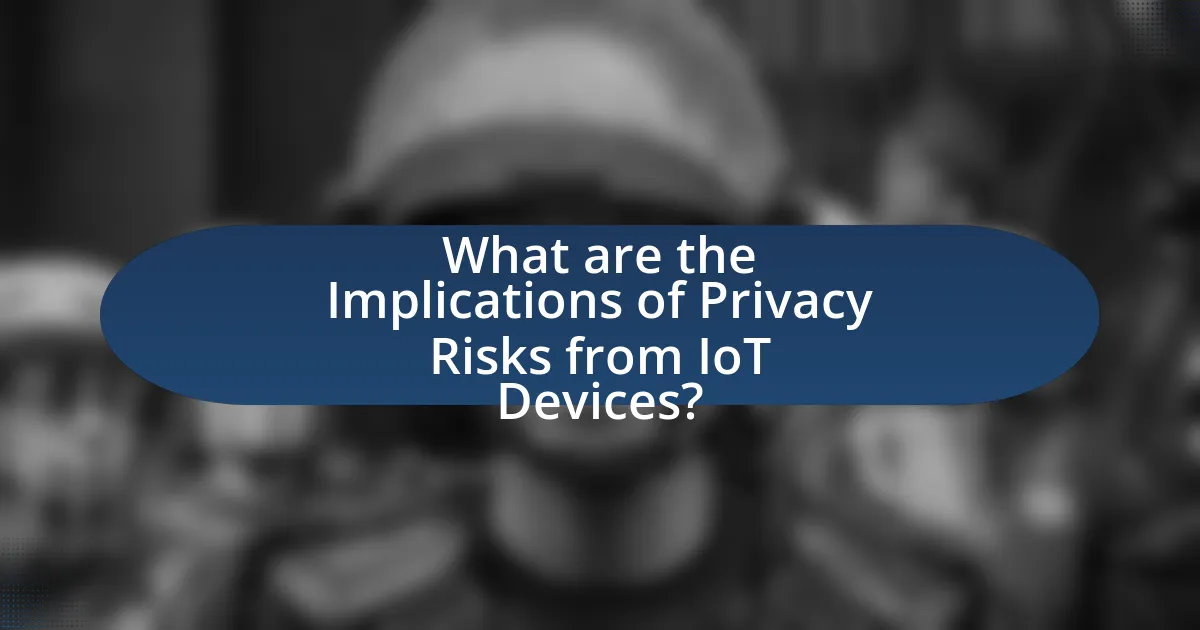
What are the Implications of Privacy Risks from IoT Devices?
The implications of privacy risks from IoT devices include unauthorized data access, surveillance, and data breaches. IoT devices often collect sensitive personal information, which can be exploited by malicious actors if proper security measures are not in place. For instance, a 2020 report by the Internet of Things Security Foundation highlighted that 98% of IoT devices are vulnerable to cyberattacks due to inadequate security protocols. This vulnerability can lead to significant privacy violations, including identity theft and unauthorized tracking of individuals. Furthermore, the pervasive nature of these devices can result in constant surveillance, eroding personal privacy and autonomy.
How do privacy risks affect individuals?
Privacy risks affect individuals by exposing their personal information to unauthorized access and misuse. When privacy is compromised, individuals may face identity theft, financial loss, and emotional distress. For instance, a study by the Identity Theft Resource Center reported that in 2020, over 1,100 data breaches exposed the personal information of more than 300 million individuals in the United States alone. This highlights the tangible consequences of privacy risks, as affected individuals often experience long-term repercussions, including damage to their credit scores and increased vulnerability to further attacks.
What are the potential consequences of data breaches?
Data breaches can lead to significant consequences, including financial loss, reputational damage, and legal repercussions. Organizations may face costs related to remediation, regulatory fines, and potential lawsuits, with the average cost of a data breach estimated at $4.35 million according to the IBM Cost of a Data Breach Report 2022. Additionally, breaches can erode customer trust, resulting in lost business and long-term damage to brand reputation. Furthermore, sensitive personal information exposed during a breach can lead to identity theft and fraud, impacting individuals and organizations alike.
How can personal data misuse impact daily life?
Personal data misuse can significantly disrupt daily life by leading to identity theft, financial loss, and erosion of privacy. When personal information is improperly accessed or shared, individuals may experience unauthorized transactions, resulting in monetary damage; according to the Federal Trade Commission, identity theft affected over 1.4 million consumers in 2020 alone. Additionally, misuse of personal data can lead to targeted scams and harassment, as malicious actors exploit sensitive information. This not only affects financial stability but also creates a pervasive sense of insecurity and anxiety in personal and professional environments.
What are the broader societal implications of IoT privacy risks?
The broader societal implications of IoT privacy risks include increased surveillance, erosion of personal privacy, and potential misuse of personal data. As IoT devices proliferate, they collect vast amounts of personal information, leading to a society where individuals are constantly monitored. This surveillance can result in a chilling effect on free expression and behavior, as people may alter their actions due to the awareness of being watched. Furthermore, the erosion of personal privacy can diminish trust in institutions and technology, as individuals become wary of how their data is used and shared. The potential misuse of personal data by corporations or malicious actors can lead to identity theft, discrimination, and manipulation, impacting social dynamics and individual autonomy. These implications highlight the need for robust privacy protections and regulations to safeguard individuals in an increasingly connected world.
How can IoT privacy issues affect public trust in technology?
IoT privacy issues can significantly undermine public trust in technology by raising concerns about data security and personal privacy. When individuals perceive that their personal information is at risk due to inadequate protections in IoT devices, they are less likely to adopt and engage with such technologies. For instance, a 2021 survey by the Pew Research Center found that 81% of Americans feel that the potential risks of data collection by companies outweigh the benefits. This perception of risk leads to skepticism and reluctance to embrace IoT innovations, ultimately hindering technological advancement and adoption.
What are the potential legal implications for companies?
The potential legal implications for companies utilizing Internet of Things (IoT) devices include liability for data breaches, compliance with privacy regulations, and exposure to lawsuits from consumers. Companies may face legal action if they fail to protect sensitive data collected by IoT devices, as evidenced by the General Data Protection Regulation (GDPR) in Europe, which imposes strict penalties for non-compliance, including fines up to 4% of annual global revenue. Additionally, companies must navigate various state and federal laws regarding consumer privacy, such as the California Consumer Privacy Act (CCPA), which grants consumers rights over their personal information and imposes obligations on businesses to disclose data collection practices. Failure to adhere to these regulations can result in significant legal consequences, including financial penalties and reputational damage.
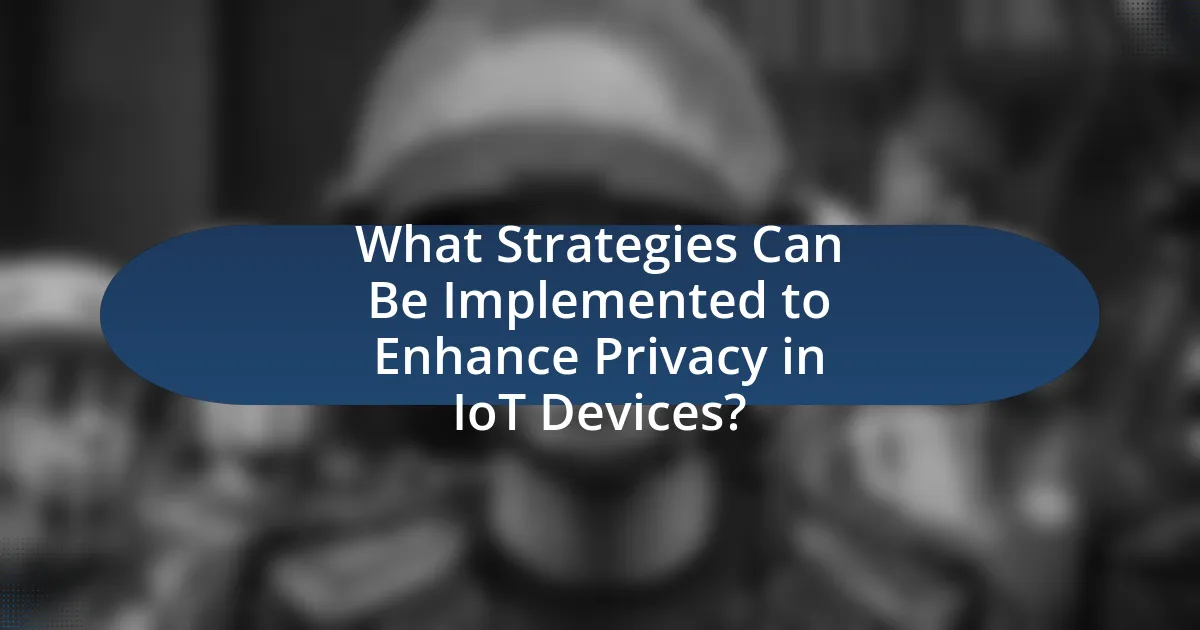
What Strategies Can Be Implemented to Enhance Privacy in IoT Devices?
To enhance privacy in IoT devices, implementing strong encryption protocols is essential. Encryption protects data transmitted between devices and servers, making it difficult for unauthorized parties to access sensitive information. For instance, using AES (Advanced Encryption Standard) can secure data at rest and in transit, ensuring that even if data is intercepted, it remains unreadable. Additionally, regular software updates are crucial, as they patch vulnerabilities that could be exploited by attackers. Research indicates that 70% of IoT devices are vulnerable due to outdated software, highlighting the importance of maintaining current security measures. Furthermore, employing robust authentication methods, such as multi-factor authentication, can significantly reduce the risk of unauthorized access. By combining these strategies, IoT devices can achieve a higher level of privacy protection.
How can manufacturers improve IoT device security?
Manufacturers can improve IoT device security by implementing robust encryption protocols for data transmission and storage. This approach ensures that sensitive information is protected from unauthorized access during communication and while at rest. According to a report by the Internet of Things Security Foundation, devices that utilize strong encryption are significantly less vulnerable to cyberattacks, reducing the risk of data breaches by up to 80%. Additionally, manufacturers should regularly update firmware to patch vulnerabilities, conduct thorough security assessments, and adopt secure coding practices to further enhance the overall security posture of IoT devices.
What best practices should be followed during device design?
Best practices during device design include implementing strong security measures, ensuring data encryption, and prioritizing user privacy. Strong security measures, such as regular software updates and vulnerability assessments, help protect devices from unauthorized access. Data encryption safeguards sensitive information transmitted between devices and servers, reducing the risk of data breaches. Prioritizing user privacy involves designing devices that collect minimal personal data and providing users with clear privacy settings and controls. These practices are essential for mitigating risks associated with Internet of Things (IoT) devices, as evidenced by studies showing that over 70% of IoT devices are vulnerable to attacks if not properly secured.
How can regular security audits enhance device safety?
Regular security audits enhance device safety by identifying vulnerabilities and ensuring compliance with security standards. These audits systematically evaluate the security posture of IoT devices, revealing weaknesses that could be exploited by attackers. For instance, a study by the Ponemon Institute found that organizations conducting regular security audits experienced 50% fewer data breaches compared to those that did not. By addressing identified vulnerabilities promptly, organizations can significantly reduce the risk of unauthorized access and data breaches, thereby improving overall device safety.
What role do regulations play in protecting privacy?
Regulations play a crucial role in protecting privacy by establishing legal frameworks that govern the collection, use, and sharing of personal data. These regulations, such as the General Data Protection Regulation (GDPR) in the European Union, set strict guidelines for organizations to follow, ensuring that individuals have control over their personal information. For instance, GDPR mandates that companies obtain explicit consent from users before processing their data, thereby enhancing user privacy and accountability. Additionally, regulations often impose penalties for non-compliance, which incentivizes organizations to prioritize data protection measures. This structured approach helps mitigate risks associated with the Internet of Things (IoT) devices, which often collect vast amounts of personal data, thereby reinforcing the importance of privacy in a rapidly evolving digital landscape.
How can legislation impact the development of IoT privacy standards?
Legislation can significantly impact the development of IoT privacy standards by establishing mandatory compliance requirements for data protection and user privacy. For instance, regulations like the General Data Protection Regulation (GDPR) in Europe set clear guidelines for how personal data must be handled, compelling IoT manufacturers to implement robust privacy measures. This legal framework not only influences the design and functionality of IoT devices but also encourages innovation in privacy-enhancing technologies, as companies seek to meet regulatory standards while maintaining competitive advantages.
What are the current regulations governing IoT privacy?
Current regulations governing IoT privacy include the General Data Protection Regulation (GDPR) in the European Union, which mandates strict data protection and privacy measures for personal data, including data collected by IoT devices. Additionally, the California Consumer Privacy Act (CCPA) in the United States provides consumers with rights regarding their personal information, impacting how IoT companies handle data. The Federal Trade Commission (FTC) also enforces regulations against unfair or deceptive practices related to IoT privacy. These regulations collectively aim to enhance consumer protection and ensure transparency in data handling by IoT devices.
What practical steps can consumers take to safeguard their privacy?
Consumers can safeguard their privacy by implementing strong security measures for their Internet of Things (IoT) devices. This includes changing default passwords to unique, complex passwords, which is crucial as default passwords are often easily accessible to hackers. Additionally, consumers should regularly update the firmware of their devices to patch vulnerabilities; a study by the Ponemon Institute found that 60% of data breaches are linked to unpatched vulnerabilities. Furthermore, consumers should disable unnecessary features, such as remote access, which can expose devices to external threats. Using a separate network for IoT devices can also enhance security, as it limits access to the main home network. Lastly, consumers should review privacy settings and permissions for each device to ensure minimal data sharing, as many devices collect more data than necessary.
How can users configure their IoT devices for better privacy protection?
Users can configure their IoT devices for better privacy protection by changing default passwords, enabling two-factor authentication, and regularly updating firmware. Changing default passwords prevents unauthorized access, as many devices come with easily guessable credentials. Enabling two-factor authentication adds an extra layer of security, making it harder for intruders to gain access even if they have the password. Regularly updating firmware ensures that devices have the latest security patches, which protect against known vulnerabilities. According to a 2021 report by the Internet of Things Security Foundation, 70% of IoT devices are vulnerable to attacks due to outdated software, highlighting the importance of these configurations for maintaining privacy.
What resources are available for consumers to stay informed about IoT privacy risks?
Consumers can stay informed about IoT privacy risks through various resources, including government websites, consumer advocacy organizations, and technology blogs. The Federal Trade Commission (FTC) provides guidelines and reports on IoT privacy, emphasizing consumer rights and data protection. Organizations like the Electronic Frontier Foundation (EFF) offer insights and tools for understanding privacy implications of IoT devices. Additionally, reputable technology blogs and news outlets frequently publish articles and analyses on emerging IoT privacy issues, helping consumers stay updated on best practices and potential risks.
